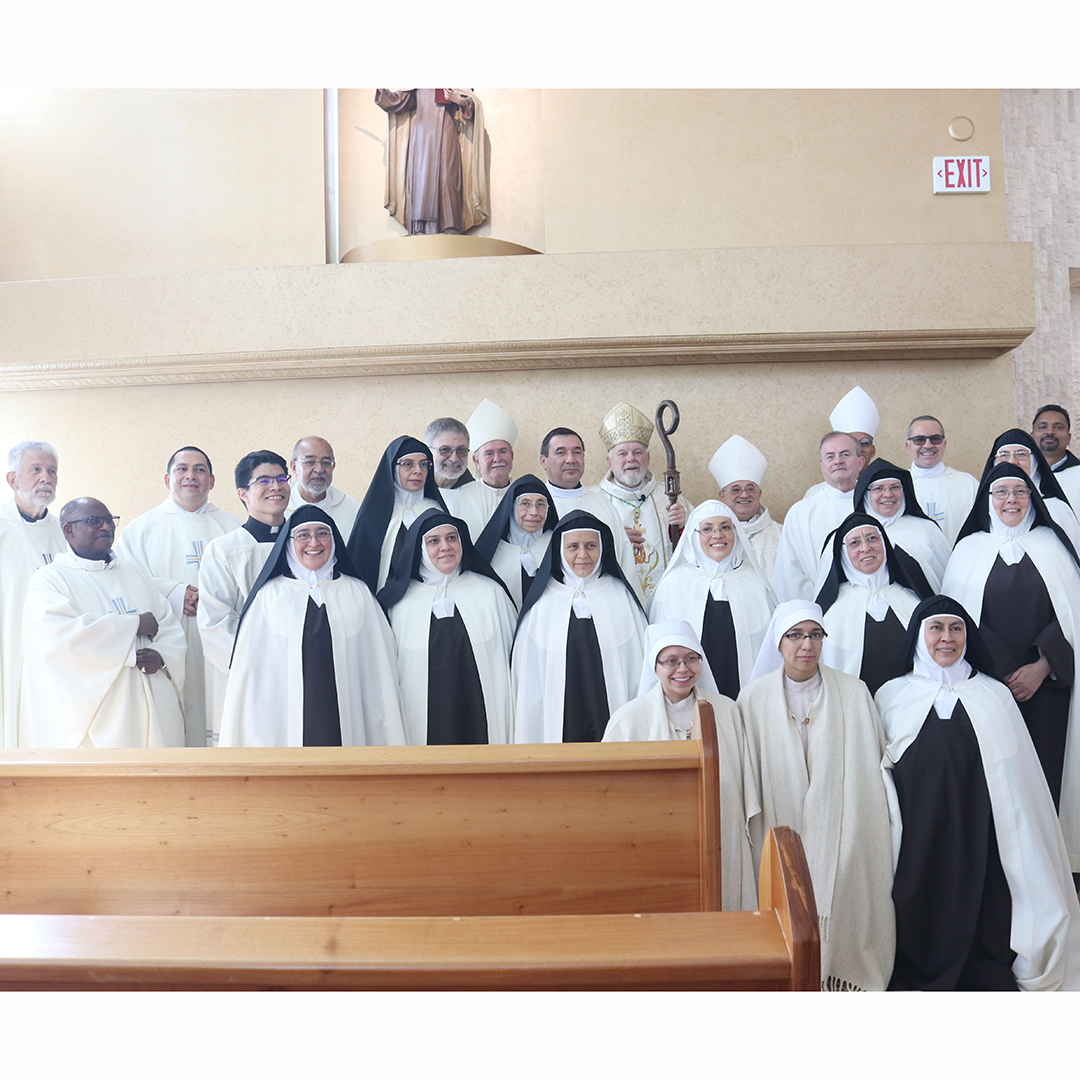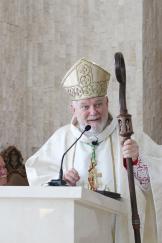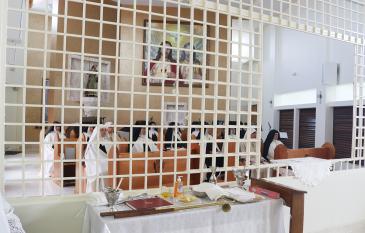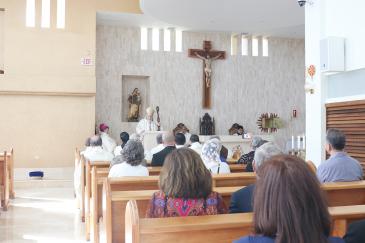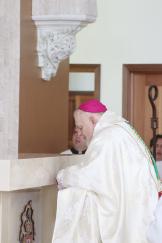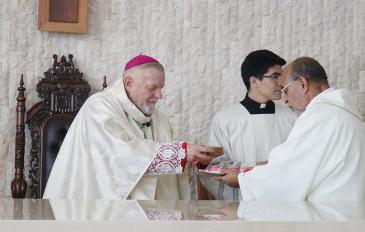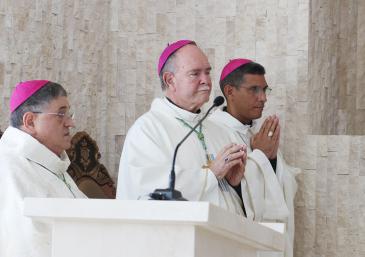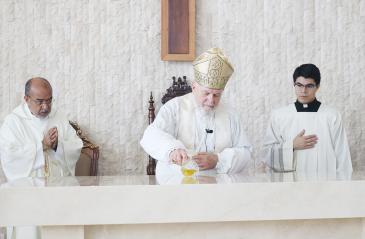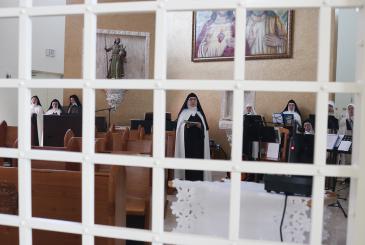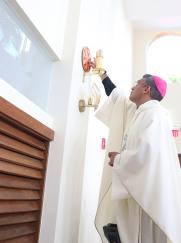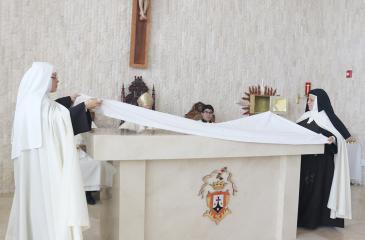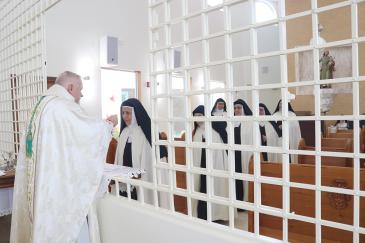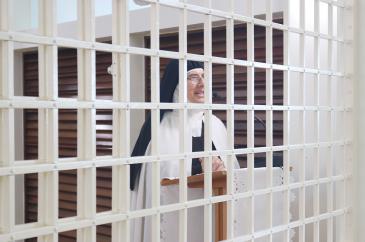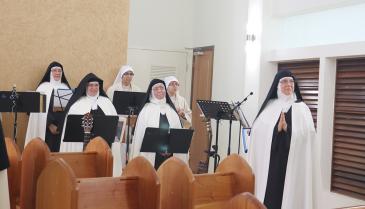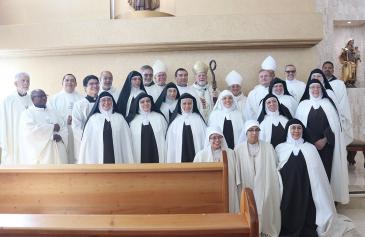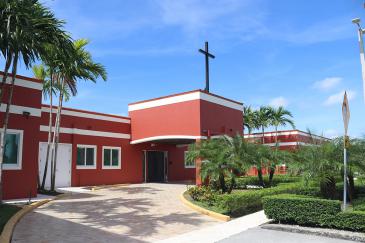By Maria Eugenia Biord - La Voz Catolica
Photography: ROCIO GRANADOS | FC
REDLANDS | After 23 years, the Discalced Carmelite nuns fulfilled their dream: to build their own monastery. That long-awaited day came Oct. 10, 2024, when Archbishop Thomas Wenski consecrated the chapel of their Holy Trinity monastery in Redlands, Homestead.
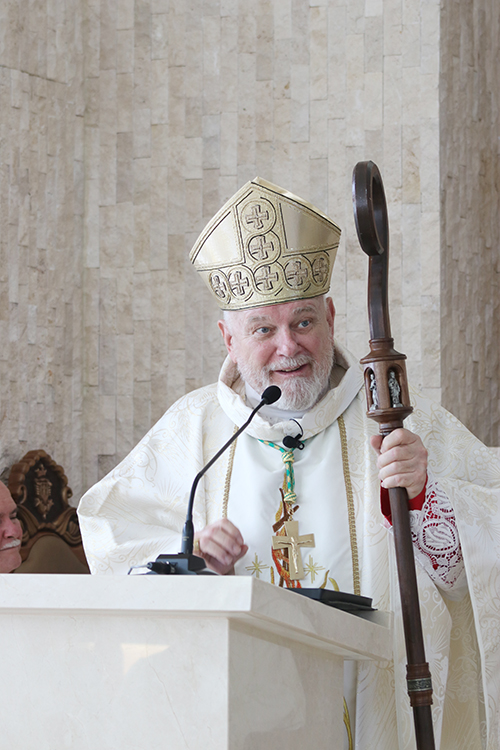
Photographer: ROCIO GRANADOS | FC
Archbishop Thomas Wenski thanks the Discalced Carmelite Mothers "for their silent and prayerful presence" in the Archdiocese of Miami during his homily at the consecration Mass of the Holy Trinity Carmelite Monastery in Homestead Oct. 10, 2024.
The Discalced Carmelites are the only contemplative order in the Archdiocese of Miami.
“It is, dear Carmelite Sisters, a grace and a blessing to have your silent and prayerful presence in the very heart of our Archdiocese of Miami, and in a special way, the contemplative religious life you embody, following in the footsteps and charism of St. Teresa of Avila,” Archbishop Wenski said during his homily.
Archbishop Wenski consecrated the altar with chrism oil and incense, and the concelebrating Bishops — Enrique Delgado, Auxiliary of Miami, and Eloy Ricardo Domínguez Martínez, Auxiliary of Havana — consecrated the walls of the chapel with chrism oil. Retired Bishop Fernando Isern of Pueblo, Colorado, and several archdiocesan priests also participated in the consecration.
A relic of the young Italian martyr St. Maria Goretti (1890-1902), donated by Father Jaime Acevedo, pastor of St. Mark’s Church in Southwest Ranches, was placed in the altar.
The chapel is divided into two sections: one for the cloistered nuns and the other for the parishioners.
The marble altar with the coat of arms of the religious order is on the nuns’ side, and an altar crucifix is on a white stone wall.
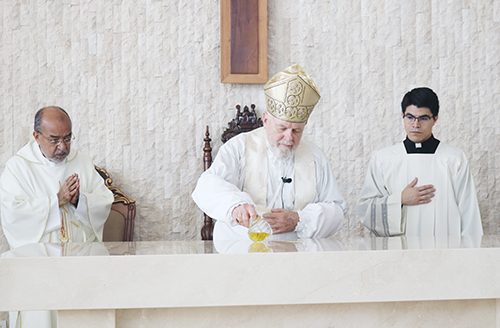
Photographer: ROCIO GRANADOS | FC
Archbishop Thomas Wenski consecrates the new altar with chrism oil at Mass Oct. 10, 2024, during which he consecrated the chapel of the Carmelite Monastery in Homestead. He is accompanied by Deacon Vitor Pimentel (left), director of the Archdiocesan Office of Deacons, and Father Agustin Estrada, priest secretary to the Archbishop.
On the right is Our Lady of Mount Carmel, and on the sides are the images of St. John of the Cross and St. Teresa of Avila. The pews and wooden furnishings were donated by the Carmelite Order of Mexico.
“Today is a day of thanksgiving,” said the current superior Mother Blanca Flor. “It is a patent miracle” because, as Archbishop Wenski recalled, after “many delays and complications,” the day finally came when “the Lord made it possible.”
“It is a dream come true. Today is a day of joy, because the community is already established in the monastery,” said Mother Berkys María with joy.
María Mercedes Escobar, president of the Secular Order of the Discalced Carmelites in Miami, said that “it was a very special ceremony.”
She collaborated with this project for several years and “it is exciting to share this moment,” she added.
“Something in my heart told me that I had to help make this happen,” said Ingrid Feijoo, who contributed financially in fulfillment of a promise. She said she has always been drawn by “the sacrifice they make to pray for each of us.” “It was a very long journey, but the Lord gave it all,” said Muñeca Fuentes, who collaborates with the nuns.
FULFILLING A DREAM THROUGH A DREAM
The Discalced Carmelite nuns were able to fulfill their dream through a dream.
In 2001, eight nuns from Querétaro, Mexico, arrived in Miami and founded the first contemplative community in the archdiocese at the request of Archbishop Emeritus John C. Favalora.
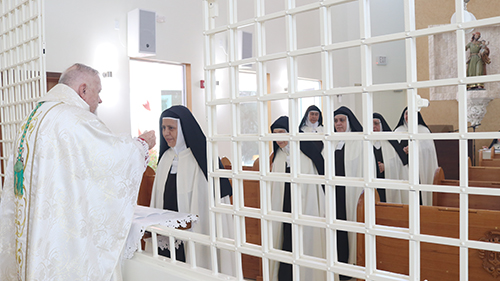
Photographer: ROCIO GRANADOS | FC
Archbishop Thomas Wenski gives Communion to Mother Blanca Flor de Jesús Sacramentado superior of the Discalced Carmelites during the consecration Mass of the chapel of their monastery in Homestead, Oct. 10, 2024.
“He wanted to establish a contemplative Community life that could pray for the families and especially for the priests of the archdiocese,” said Mother Teresa López, the superior of the community at the time.
As time went by, vocations from other nationalities such as Colombia, Nicaragua and Cuba joined the community, and now there are 12 nuns and two postulants.
Upon their arrival, they lived in a house at St. Thomas the Apostle Parish, in Miami. Soon after, they moved to the convent on the grounds of Immaculate Conception Church in Hialeah. It was there that the first vocation from Miami, Ana Carolina del Corazón Misericordioso, professed her vows.
In 2009 they found land in Homestead. It seemed like the right place, but they feared the distance would make it difficult to celebrate daily Mass. God sent a sign. “One day, eight young people showed up at our door with religious concerns — they were from Homestead!” said Mother Blanca Flor.
In 2010, they purchased the five-acre site in Homestead with contributions from other Discalced Carmelite monasteries, the archdiocese, and donors. Groundbreaking took place a year later, in September 2011.
Raising the funds for the next phase was the new challenge. “We prayed a lot to our Lord and to St. John Paul II,” recalled Mother Blanca Flor.
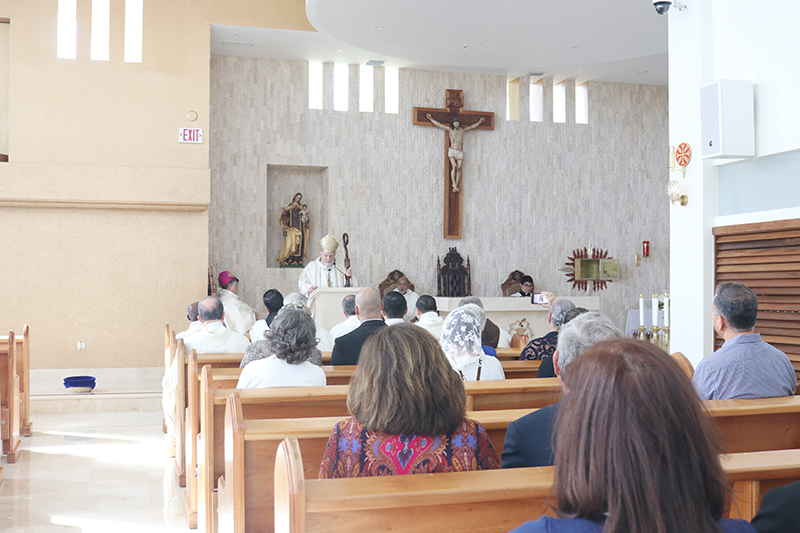
Photographer: ROCIO GRANADOS | FC
Archbishop Thomas Wenski thanks the Discalced Carmelite Mothers "for their silent and prayerful presence" in the Archdiocese of Miami during his homily at the consecration Mass of the Holy Trinity Carmelite Monastery in Homestead Oct. 10, 2024.
Construction began in 2014, but money was needed: They had to raise funds.
One morning, Mother Angelica said she had a dream in which “the Lord told her that the solution for the monastery was in her bedside table,” Mother Blanca Flor said.
Searching, they found the recipe for granola bars. Without spending much time, the nuns began the project of making and selling granola bars. This, along with other homemade sweets and religious items, led them to visit several parishes in Miami.
“The granola bars were the excuse” for an enriching pilgrimage, according to Mother Blanca Flor. “It allowed us to get closer to the mission and ministry of the priest.” They felt the daily work. A meaningful bond was woven, “they in their apostolate and we in prayer,” she said.
The nuns received generous donations from the Archdiocese of Miami, from priests, a posthumous donation from Msgr. Tomás Marín, from benefactors, and even from a stranger who left “soda cans full of pennies in the mailbox at the little house in Hialeah,” Fuentes recalled. “The Divine Providence doesn’t let us down,” added Mother Blanca Flor.
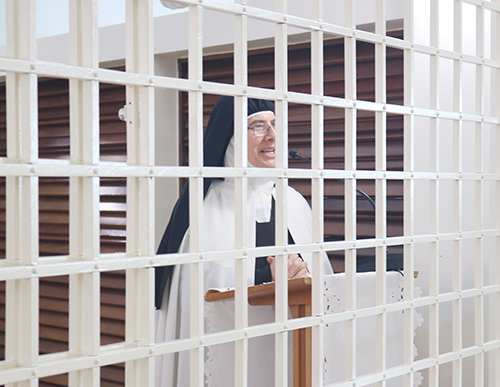
Photographer: ROCIO GRANADOS | FC
Carmelite Mother Alba Mery de Jesus thanks Archbishop Thomas Wenski and the bishops and priests who participated in the consecration of the chapel of her monastery in Homestead Oct. 10, 2024.
Construction continued slowly until architect Carlos Flores took over in recent years. “They were going through a difficult time and I stepped in to help,” Flores said. He is pleased to have successfully contributed to the completion of the project and noted that from the first day, he felt “welcomed by the sisters and now I feel closer to God.”
Problems were not lacking, recalled Mother Blanca Flor. After the coronavirus pandemic in 2020, they stopped selling granola bars, because “the Lord told us, ‘Take care of Me and I will take care of you.’”
Since then, “we have lacked nothing, and Our Lord has revealed to us His desire to be honored in His Holy Face.” The prayers have borne fruits, as last year “we obtained habitability (Certificate of Occupancy)," she said.
Life in the cloister begins early, with daily Eucharist, community prayers, assigned chores, and individual meditations, Mother Berkys said. “We make scapulars to support ourselves; we have the distribution of hosts in the archdiocese; people bring us vegetables and we have a garden,” Mother Teresa explained.
The surrounding community has welcomed them enthusiastically, and Father Robes Charles, pastor of Sacred Heart in Homestead, celebrates Sunday Masses at 10 a.m. in Spanish, which are open to the public.
The convent has rooms for 26 nuns, an oratory for the novices in formation, and a hermitage, where “once a month a sister retires to pray,” said Mother Blanca Flor.
After a year in the convent, repairs are still needed. “We need protection against hurricanes and floods,” Mother Blanca Flor noted. The roof also needs to be repaired, and “the budget is beyond our means, but not beyond God’s,” she added.
Therefore, they are still in need of donations and help.
To raise funds, they have planned two exhibitions: one for Christmas and another about the Holy Face.
“In addition to raising funds, we want more worship for our Lord,” Mother Blanca Flor emphasized. As Archbishop Wenski pointed out in his homily, “St. Teresa of Avila herself says: Let nothing disturb you... God alone is enough.”
“Our mission is to be a small flickering lamp, constantly talking to the Lord, touching His heart and asking His mercy,” summarized Mother Teresa, who is approaching her 55th year of consecrated life.
FOR MORE INFORMATION
- To make a donation, call 305-558-7122
- or mail it to:
Discalced Carmelite NunsHoly Trinity Monastery
29190 S.W. 209th Ave.,Homestead, FL 33030.
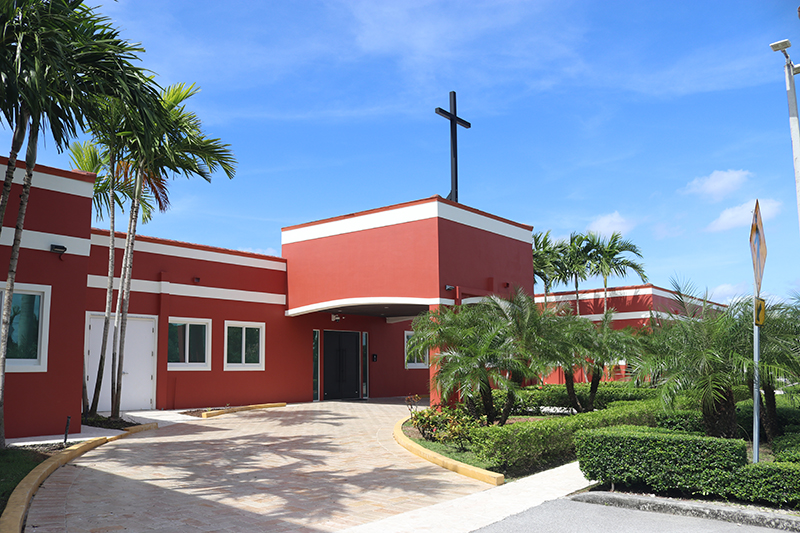
Photographer: ROCIO GRANADOS | FC
A view of the exterior of the cloistered Monastery of the Holy Trinity of the Carmelite Mothers in Homestead.
